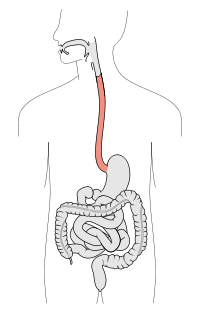
Photo from wikipedia
Study Design. Prospective cohort study. Objective. Our primary study was to investigate whether the degree of postoperative facet and disk space distraction following anterior cervical discectomy and fusion (ACDF) affects… Click to show full abstract
Study Design. Prospective cohort study. Objective. Our primary study was to investigate whether the degree of postoperative facet and disk space distraction following anterior cervical discectomy and fusion (ACDF) affects the rate of postoperative dysphagia. Summary of Background Data. Although ACDF is safe and well tolerated, postoperative dysphagia remains a common complication. Intervertebral disk space distraction is necessary in ACDF to visualize the operative field, prepare the endplates for fusion, and facilitate graft insertion. However, the degree of distraction tolerated, before onset of dysphagia, is not well characterized ACDF. Materials and Methods. A prospective cohort study was conducted of 70 patients who underwent ACDF between June 2018 and January 2019. Two independent reviewers measured all preoperative and postoperative radiographs measured for interfacet distraction distance and intervertebral distraction distance, with intrareviewer reproducibility measurements after one month. For multilevel surgery, the level with the greatest distraction was measured. Primary outcomes were numerical dysphagia (0–10), Eating Assessment Tool 10, and Dysphagia Symptom Questionnaire score collected at initial visit and two, six, 12, and 24 weeks postoperatively. Results. A total of 70 patients were prospectively enrolled, 59 of whom had adequate radiographs. An average of 1.71 (SD: 0.70) levels were included in the ACDF construct. Preoperatively, 13.4% of patients reported symptoms of dysphagia, which subsequently increased in the postoperative period at through 12 weeks postoperatively, before returning to baseline at 24 weeks. Intrareviewer and interreviewer reliability analysis demonstrated strong agreement. There was no relationship between interfacet distraction distance/intervertebral distraction distance and dysphagia prevalence, numerical rating, Eating Assessment Tool 10, or Dysphagia Symptom Questionnaire. Conclusions. Patients who had an ACDF have an increased risk of dysphagia in the short term, however, this resolved without intervention by six months. Our data suggests increased facet and intervertebral disk distraction does not influence postoperative dysphagia rates. Level of Evidence: 3.
Journal Title: Spine
Year Published: 2022
Link to full text (if available)
Share on Social Media: Sign Up to like & get
recommendations!